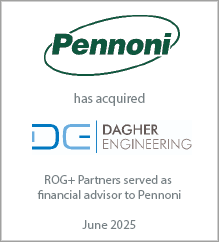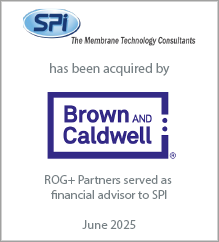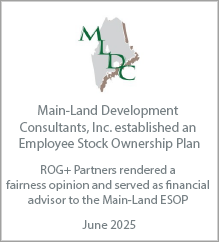Steve Gido specializes in corporate financial advisory services with a focus on mergers and acquisitions. Steve has assisted architecture, engineering, environmental consulting and construction firms of all sizes across North America achieve their growth or liquidity goals through successful mergers & acquisitions. Steve has over 15 years of investment banking experience and holds the chartered financial analyst (CFA) designation from the CFA Institute.
Which Path To Choose – The Internal or External Sale?
November 12, 2015
2015 marks the year that individuals born in the 1950s will turn somewhere between 56 and 65, typically prime years for ownership transition and monetization of equity stakes heading into retirement. But for A/E owners who have survived the recession and are back on track financially, many remain conflicted as to which is the best course for them to effectively exit their organizations. As we have witnessed over the past few years, the “sell down” internal transition or “sell out” external option are not always mutually exclusive.
Let me offer two anecdotes to illustrate my point:
1. Our team undertakes many internal transition engagements each year where our role is to conduct a valuation and then consult with the buyers and sellers to create an orderly process to move blocks of shares over time. In many instances, the older shareholders – those with large stock positions – have groomed a new generation of employees on the benefits of becoming an owner, and are confident that “passing the torch” will be relatively effortless.
In some cases, once a letter of intent was negotiated and signed with a buyer, the owners began to share the news with their key employees and younger leaders only to find a surprising response – “Please don’t sell!” Minority shareholders or key non-owners, who are influential in the long-run direction of business development and integration, were vocal opponents to the sale. Senior leaders just assumed the interest was never there internally. That revelation can create awkward tensions between the buyer and seller, but also serve to initiate a “fresh start” dialogue on keeping the firm independent through an internal buyout.
So to help with the decision making process, we thought we would offer our own sentiments and pros and cons on assessing the two main transition alternatives.
The Internal Option
For all the promotion and headlines on industry M&A activity, the reality is that the vast number of A/E firms pursue the internal transition path. Principals and partners perpetuate the organization by putting procedures in place to transfer shares to other individuals they have selected and developed. These programs can take the form of direct buy-sell arrangements, using the company or deferred compensation as a conduit, or implementing an Employee Stock Ownership Plan (ESOP) or a similar participatory arrangement.
Assuming there are willing buyers, the nice part about the internal transition is that employee-managers retain operational control and can dictate their own destiny and strategic vision. For traditional internal programs, ownership can remain exclusive to certain individuals and serve as a motivational aspect to drive performance. In addition, many younger buyers are pleasantly surprised with the strong return on investment these opportunities can afford. With ESOPs, there are often significant tax savings that come along with implementation and they also serve as a new company benefit that all employees can participate in. ESOPs typically offer higher valuations than traditional buy-sell models, primarily due to their enhanced liquidity feature.
The main drawbacks to the traditional internal transition are that it typically affords the lowest valuation (compared to other options) and often has the longest payout period. Depending on the number of sellers, it is not uncommon to see payouts take place over 5-10 (or more!) years. Future cash flow required for retiring shareholder debt can squeeze out other firm priorities such as new software and equipment, incentive compensation, and working capital needs.
ESOPs have their own funding, administrative, and annual appraisal costs to implement and maintain. In addition, ESOPs can also dilute the value to other current shareholders. In some extreme cases, leaders have removed their ESOP as they discovered it was never properly communicated as an advantage or employees simply don’t value the benefit. For ESOPs in particular, success really does depend on the specific culture of one’s organization.
The External (M&A) Option
Assuming the firm has marketable characteristics, the lure of selling to an outside buyer typically brings the highest valuation and fastest liquidity. While no two A/E deals are alike, it’s customary to have some portion of the consideration in cash at closing with perhaps 2-5 years in an installment note for the balance. A compressed horizon as well as taking future payments from a larger, well-financed buyer often reduces that risk element to owners. Larger firms can sometimes bring additional financial, marketing, and recruiting resources, new career options and opportunities to a seller’s staff, and ancillary disciplines to clients for “one-stop shopping” purposes.
The biggest drawback in selling is giving up operational control and independence to a new entity. Many A/E owners who started their practices after working in larger firms don’t always relish the prospect of rejoining companies with different cultures, organizational layers, rules and controls, and more formal business practices. As we see every year, A/E M&A deals are delicate and fraught with integration risk. Roles change, benefits and processes are different, and there is the real worry that key staff and clients will leave over time. Managing expectations and minimizing surprises for both parties is a critical component of successful deal making.
***
Given aging demographics and an evolving competitive landscape, we believe there will be increasingly more net sellers of stock than buyers, with wide ramifications on future valuations and marketability. Having realistic transition options and long-term planning is critical. Do these situations sound familiar? Let us know. ROG + Partners brings years of seasoned financial and business experience in navigating A/E and environmental clients of all backgrounds through strategic and ownership alternatives.
Let me offer two anecdotes to illustrate my point:
1. Our team undertakes many internal transition engagements each year where our role is to conduct a valuation and then consult with the buyers and sellers to create an orderly process to move blocks of shares over time. In many instances, the older shareholders – those with large stock positions – have groomed a new generation of employees on the benefits of becoming an owner, and are confident that “passing the torch” will be relatively effortless.
However, even with the best of intentions, those internal transfer discussions can break down. Young employees don’t have the financial resources or are simply risk averse to the concept; valuation differences between the parties create tension and resentment; or senior leaders (oftentimes first generation owners) have second thoughts on their staff’s ability to successfully run the firm. Long, simmering partner grudges as well as elements of greed and ego enter into the mix. The process never gains traction and frustrations lead to fragility. Senior leaders surmise that perhaps selling out to a larger A/E firm will be easier and begin to chart a new path.
2. Alternatively, we have M&A assignments where controlling shareholders conclude that selling the firm is in the best interest for everyone involved. Every year, they encounter larger and more formidable competitors, a consolidating industry, new client demands, and increasing business costs and pressures.
In some cases, once a letter of intent was negotiated and signed with a buyer, the owners began to share the news with their key employees and younger leaders only to find a surprising response – “Please don’t sell!” Minority shareholders or key non-owners, who are influential in the long-run direction of business development and integration, were vocal opponents to the sale. Senior leaders just assumed the interest was never there internally. That revelation can create awkward tensions between the buyer and seller, but also serve to initiate a “fresh start” dialogue on keeping the firm independent through an internal buyout.
In our discussions with owners of every firm size and discipline, the names are different but the dilemmas and options remain the same. We hear, “We’d like to sell internally but just aren’t sure we have the right entrepreneurial people to make it work.” Another common lament is, “Selling to an outside buyer sounds appealing, but I’m concerned about the changes it would bring to our culture and operations.” Trust us – these are truly existential decisions many A/E owners face today as they evaluate their firm’s sustainability and survivability. In addition, the plain reality is that individuals’ ownership stakes constitute a sizable portion of their portfolios and retirement savings and thus, are naturally anxious about unlocking that value.
So to help with the decision making process, we thought we would offer our own sentiments and pros and cons on assessing the two main transition alternatives.
The Internal Option
For all the promotion and headlines on industry M&A activity, the reality is that the vast number of A/E firms pursue the internal transition path. Principals and partners perpetuate the organization by putting procedures in place to transfer shares to other individuals they have selected and developed. These programs can take the form of direct buy-sell arrangements, using the company or deferred compensation as a conduit, or implementing an Employee Stock Ownership Plan (ESOP) or a similar participatory arrangement.
Assuming there are willing buyers, the nice part about the internal transition is that employee-managers retain operational control and can dictate their own destiny and strategic vision. For traditional internal programs, ownership can remain exclusive to certain individuals and serve as a motivational aspect to drive performance. In addition, many younger buyers are pleasantly surprised with the strong return on investment these opportunities can afford. With ESOPs, there are often significant tax savings that come along with implementation and they also serve as a new company benefit that all employees can participate in. ESOPs typically offer higher valuations than traditional buy-sell models, primarily due to their enhanced liquidity feature.
The main drawbacks to the traditional internal transition are that it typically affords the lowest valuation (compared to other options) and often has the longest payout period. Depending on the number of sellers, it is not uncommon to see payouts take place over 5-10 (or more!) years. Future cash flow required for retiring shareholder debt can squeeze out other firm priorities such as new software and equipment, incentive compensation, and working capital needs.
ESOPs have their own funding, administrative, and annual appraisal costs to implement and maintain. In addition, ESOPs can also dilute the value to other current shareholders. In some extreme cases, leaders have removed their ESOP as they discovered it was never properly communicated as an advantage or employees simply don’t value the benefit. For ESOPs in particular, success really does depend on the specific culture of one’s organization.
The External (M&A) Option
Assuming the firm has marketable characteristics, the lure of selling to an outside buyer typically brings the highest valuation and fastest liquidity. While no two A/E deals are alike, it’s customary to have some portion of the consideration in cash at closing with perhaps 2-5 years in an installment note for the balance. A compressed horizon as well as taking future payments from a larger, well-financed buyer often reduces that risk element to owners. Larger firms can sometimes bring additional financial, marketing, and recruiting resources, new career options and opportunities to a seller’s staff, and ancillary disciplines to clients for “one-stop shopping” purposes.
The biggest drawback in selling is giving up operational control and independence to a new entity. Many A/E owners who started their practices after working in larger firms don’t always relish the prospect of rejoining companies with different cultures, organizational layers, rules and controls, and more formal business practices. As we see every year, A/E M&A deals are delicate and fraught with integration risk. Roles change, benefits and processes are different, and there is the real worry that key staff and clients will leave over time. Managing expectations and minimizing surprises for both parties is a critical component of successful deal making.
***
Given aging demographics and an evolving competitive landscape, we believe there will be increasingly more net sellers of stock than buyers, with wide ramifications on future valuations and marketability. Having realistic transition options and long-term planning is critical. Do these situations sound familiar? Let us know. ROG + Partners brings years of seasoned financial and business experience in navigating A/E and environmental clients of all backgrounds through strategic and ownership alternatives.








